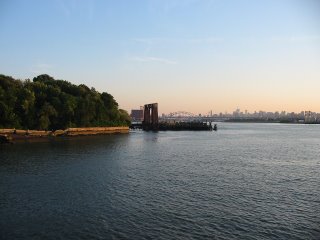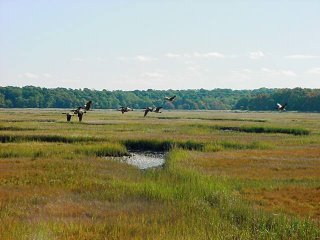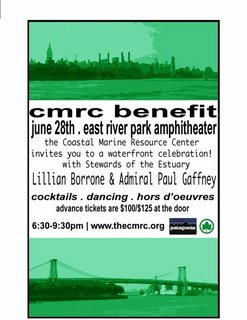The CMRC's periodically explores the agencies, organizations and individuals who act as "Stewards of the Estuary" to better understand the latest programs and projects affecting our coastlines and waterfronts. One such organization, Audubon NYC, is active in the conservation and monitoring of avian species that exist in our Harbor Estuary region. The article

below
describes their Harbor Herons Program which works to protect and restore the great wading-bird populations of our region. JB
Millions of birds inhabit our urban estuary and surrounding coastlines, using these areas for nesting, foraging and migratory routes. Recently, scientists have observed a significant increase in the amount of birds found on the most developed portions of our landscape. One organization, New York City Audubon, works to protect, monitor and raise awareness of all birds species found in the region's ecosystem.
One of the more important grouping of species from a coastal marine perspective, is that of the Harbor Herons, a group of wading birds that can be found in, on and around the waters of the New York - New Jersey Harbor Estuary. NYC Audubon has develop a program known as the Harbor Heron Project, that works exclusively to monitor and protect these species.
Harbor Herons include a wide range of birds that live near the water. This includes some very charismatic species like the Great Egret, Snowy Egret, Great Blue Heron and Black-Crowned Night Heron. These birds can often be seen along the waterways of the Harbor Estuary in the extensive mudflats, tidal marshes and shallow pools looking for prey in the water or hiding out in the reeds and nearby trees waiting for dusk, and feeding time, to arrive.
Many of these species have at some point been on the endangered species lists at both the State and Federal levels but now due to the great conservation work of groups like NYC Audubon their populations are now rebounding. Below is a brief description of the changing population numbers from the Harbor Herons site:
New York City, the Audubon, and egrets have a common history going back more than a hundred years. At the end of the Nineteenth Century, a New York City resident, George Bird Grinnell, started the first Audubon. He brought together like-minded people who hoped to stop the slaughter of egrets, which were being killed by the hundreds of thousands so that their plumes could be shipped to New York and used to decorate hats.
The millinery trade brought egrets, and several other bird species, to the brink of extinction. Grinnell's Audubon and the organizations that followed it brought protection to the egrets and scores of other beleaguered species with the enactment of the Migratory Bird Treaty Act of 1914. With new protection, egret and heron populations recovered and spread beyond their historical southern ranges. By 1960, egrets were nesting as far north as New Hampshire. There were, however, no egret colonies in New York City.
Imagine the delight of New York birders when Scotty Jenkins found egrets nesting on Pralls Island in the Arthur Kill on the western border of Staten Island! The Clean Water Act of 1972 had allowed water quality to improve enough to support prey species for the egrets.  Following Jenkin's discovery, New York City Audubon began efforts to protect the nesting site, and started an annual census of breeding herons, egrets and ibises in the city. Eighteen years later, the censuses continue and the birds are prospering.
Following Jenkin's discovery, New York City Audubon began efforts to protect the nesting site, and started an annual census of breeding herons, egrets and ibises in the city. Eighteen years later, the censuses continue and the birds are prospering.
Today the Harbor Herons Project runs many great programs of interest that support the continued conservation of these bird species. One fo their most successful efforts is an extensive volunteer monitoring network that collects data on the numbers and whereabouts of birds in the region. In addition, the Harbor Herons Project runs several outreach and education programs, most notably their Sunset Journey Eco-Island Tours that visits North and South Brother Islands and also passes by a newly found colony at Mill Rock. These tours are provided with assistance from the NY Water Taxi every Saturday throughout the summer and provide great views of the birds and the harbor and leave from South Street Seaport.
Although the Harbor Herons are coming back in droves there are certainly several threats, like development and chemical releases, that will continue to pose a threat to the different species. With the continued hard work of conservation organization like NYC Audubon and many others, we hope to see a rebound in the many birds population that inhabit the coastal waters of the New York - New Jersey Harbor Bight. The amazing success of these efforts will only continue to solidify the region as a truly urban estuary.
More info:
NYC Audubon Harbor Herons Project
http://www.nycaudubon.org/projects/harborherons/
Harbor Heron Tour Schedule
http://www.nycaudubon.org/home/SBTrip.shtml
NY Water Taxi
http://www.nywatertaxi.com/Default.aspx
 feature a performance by CMRC Benefit Host, V2 Records recording artist Moby and will honor Stewards of the Estuary Lillian Borrone and Vice Admiral Paul Gaffney for their work on the U.S. Commission on Ocean Policy.
feature a performance by CMRC Benefit Host, V2 Records recording artist Moby and will honor Stewards of the Estuary Lillian Borrone and Vice Admiral Paul Gaffney for their work on the U.S. Commission on Ocean Policy.








